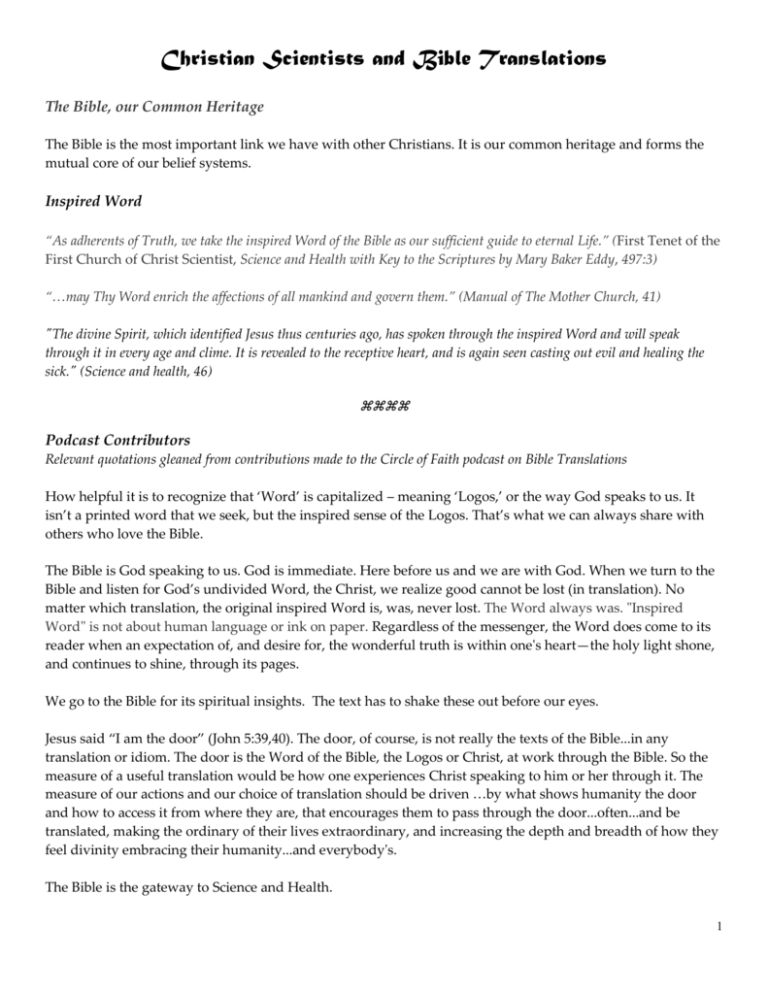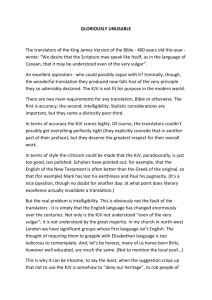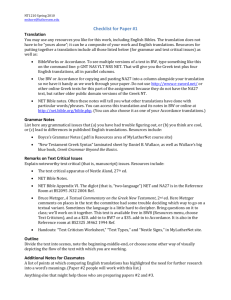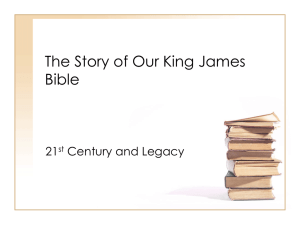Christian Scientists and Bible Translations
advertisement

Christian Scientists and Bible Translations The Bible, our Common Heritage The Bible is the most important link we have with other Christians. It is our common heritage and forms the mutual core of our belief systems. Inspired Word “As adherents of Truth, we take the inspired Word of the Bible as our sufficient guide to eternal Life.” (First Tenet of the First Church of Christ Scientist, Science and Health with Key to the Scriptures by Mary Baker Eddy, 497:3) “…may Thy Word enrich the affections of all mankind and govern them.” (Manual of The Mother Church, 41) "The divine Spirit, which identified Jesus thus centuries ago, has spoken through the inspired Word and will speak through it in every age and clime. It is revealed to the receptive heart, and is again seen casting out evil and healing the sick." (Science and health, 46) Podcast Contributors Relevant quotations gleaned from contributions made to the Circle of Faith podcast on Bible Translations How helpful it is to recognize that ‘Word’ is capitalized – meaning ‘Logos,’ or the way God speaks to us. It isn’t a printed word that we seek, but the inspired sense of the Logos. That’s what we can always share with others who love the Bible. The Bible is God speaking to us. God is immediate. Here before us and we are with God. When we turn to the Bible and listen for God’s undivided Word, the Christ, we realize good cannot be lost (in translation). No matter which translation, the original inspired Word is, was, never lost. The Word always was. "Inspired Word" is not about human language or ink on paper. Regardless of the messenger, the Word does come to its reader when an expectation of, and desire for, the wonderful truth is within one's heart—the holy light shone, and continues to shine, through its pages. We go to the Bible for its spiritual insights. The text has to shake these out before our eyes. Jesus said “I am the door” (John 5:39,40). The door, of course, is not really the texts of the Bible...in any translation or idiom. The door is the Word of the Bible, the Logos or Christ, at work through the Bible. So the measure of a useful translation would be how one experiences Christ speaking to him or her through it. The measure of our actions and our choice of translation should be driven …by what shows humanity the door and how to access it from where they are, that encourages them to pass through the door...often...and be translated, making the ordinary of their lives extraordinary, and increasing the depth and breadth of how they feel divinity embracing their humanity...and everybody's. The Bible is the gateway to Science and Health. 1 Mary Baker Eddy has brought all peoples the inspired Word that Jesus understood and practiced. She put it into her book--Science and Health with Key to the Scriptures. It is the highest "translator" of all times. This book, together with whatever Bible one chooses, can transform one's life beyond his/her greatest expectations. About The King James Version (KJV) and the Textus Receptus “Tolle, lege. Tolle, lege. Take up and read. But how shall men meditate in that which they cannot understand? How shall they understand that which is kept close in an unknown tongue? Indeed without translations into the vulgar [common] tongue, the unlearned are but like children at Jacob's well (which is deep) without a bucket or something to draw with." Miles Smith in the introduction to the original King James Version It took 30+ years after the printing of the KJV in 1611 for it to become popular—at the time the KJV was published, the Geneva Bible was the predominant translation of choice among Protestants—it was the Geneva Bible which came over to the Americas with the Pilgrims. The KJV was revised in 1769 by Benjamin Blayney, an Oxford scholar—this revision is known as the “Authorized Version” and is the standard KJV used today. The original KJV and the revised KJV are based on a Greek New Testament called the “Textus Receptus” or “Received Text. The ‘Received Text’ is not a single text. It is a collection of printed Greek New Testament texts published during the time of the Protestant Reformation in the 1500's and early 1600's. These Greek New Testament texts were based upon a small number of late medieval manuscripts. Until 1881, the Textus Receptus or Received Text was the standard Greek NT collection of texts used to translate the NT into English. In the KJV Tradition The 1800s generated a number of new translations of the Bible, for two reasons: 1. The desire to have scripture available in a modern accessible language 2. The publication (1881) of a new and standardized rendering of the New Testament in Greek based on the most recent manuscript discoveries. This Greek New Testament was accomplished over a period of 28 years (1853-1881) by two British scholars: Brooke Foss Westcott, Bishop of Durham and Professor of Divinity at Cambridge, and Fenton John Anthony Hort, also Professor of Divinity at Cambridge. Many of these 19th century translations were accomplished by individuals, for example the Webster Bible, Young’s Literal Translation, Darby Bible, and Rotherham’s Emphasized Bible BUT, the Revised Version (RV, 1881-1885) was a translation by a group of scholars commissioned by the English Church and based on the Westcott and Hort standard Greek New Testament – in fact these two scholars (Westcott and Hort) were part of the translation group. The aim of the RV was "to adapt the KJV to the present state of the English language without changing the idiom and vocabulary," and "to adapt it to the present standard of Biblical scholarship." 2 The revisers were charged with introducing alterations only if they were deemed necessary to be more accurate and faithful to the original Greek and Hebrew texts. In the New Testament alone more than 30,000 changes were made, over 5,000 on the basis of what were considered better Greek manuscripts. Most, but not all, of these changes were relatively insignificant. The Revised Version is the first offspring within the KJV family of translations. The American Standard Version (ASV, 1901), the American version of the British RV, Americanized the Revised Version. It was accomplished by 30 American scholars who had formerly corresponded with the Revised Version committee. Now there are two Bibles of the KJV family: RV and ASV, but neither are popular because, even though more accurately based on recent significant manuscript discoveries, their language was still Elizabethan English and very literal. Therefore the KJV continued its reign among American Protestants. It was so widely used during Mary Baker Eddy’s life time that it was simply referred to as ‘The Common Version.’ She clearly treasured it, as she read from it and quoted from it extensively in her own writings. And yet, the Mary Baker Eddy Library houses many other translations she owned, and she quoted from them as well. It appears that she looked into all the translations she had access to. The twentieth century brought even more translations by individuals, for example: Ferrar Fenton’s Bible (1903), Weymouth’s New Testament in Modern Speech (1903), Twentieth Century New Testament (1904), Moulton’s Modern Reader’s Bible (1907), Scofield Reference Bible (1909), The Bible—An American Translation (Goodspeed, 1939), Moffatt’s Bible (1926, 35), Knox Bible (1945, Catholic). But it was the Revised Standard Bible (RSV, 1952) which would become very popular and the first to truly replace the KJV in mainline Protestant churches. This was an excellent and thorough revision by 32 scholars with the aim to update language, incorporate recent discoveries of Greek manuscripts, and stay close to KJV tradition. Now there are three Bibles of the KJV family: RV, ASV and RSV. Some of the RSV translation scholars were also simultaneously working on an update and revision of the Westcott-Holt Greek New Testament text of 1901. This revised Greek New Testament, called the Nestle-Alan Text, was completed in 1956, and then revised again in 1983. Each revision incorporated all the latest textual research and manuscript discoveries. The Nestle-Alan Greek New Testament is based primarily on the Alexandrian family of Greek texts because this group of recently discovered manuscripts represents the earliest, dating from the 100s to the 600s. 3 To come up with a standardized Greek NT, scholars take these earliest manuscripts, and with the help of computers, examine all the variant readings, discriminate among them as to which is earlier and which are more accurate, giving special attention to the Alexandrian family of manuscripts. When there are significant variations among any of these newly discovered early manuscripts, the Nestle-Alan Text notes them. Any reputable translator bases her or his translation on the latest revision of the Nestle-Aland Greek New Testament and will also make note in the translation of any significant manuscript variants. “Acquaintance with the original texts, and willingness to give up human beliefs (established by hierarchies, and instigated sometimes by the worst passions of men), open the way for Christian Science to be understood, and make the Bible the chart of Life, where the buoys and healing currents of Truth are pointed out." (Science and Health, 24) In 1982, in reaction to the popularity of the RSV, the New King James Version (NKJV) was created. The conservative group behind this version made cosmetic changes to the KJV by updating archaic language while still seeking to keep the familiar phrasing and rhythm of the KJV. But the version remained based on the old Textus Receptus Greek text. The publication of the New Revised Standard Version (1993, NRSV) was based on the revised 1983 NestleAlan Text and therefore faithful to the most ancient texts available. This translation replaces the RSV in all the mainline Protestant churches and is endorsed by Episcopalian, Methodist, Presbyterian, and United Church of Christ (or Congregational). The RSV and NRSV represent the first major translation project to actively involve Protestant, Catholic, Orthodox Christian and Jewish scholars—a truly ecumenical, multi-religious, dialogue, using more genderinclusive language. These translations are suitable for both serious Bible study and public worship. Most respectable study Bibles are based on the NRSV, such as the Oxford Annotated Bible, HarperCollins Study Bible, and The Access Bible—also published by Oxford Univ. Press. “I can't recommend Study Bibles enough so that maps, vocabulary, study notes, cross references, even a concordance, are all there in one simple volume. Marvelous for teaching Sunday School.” (Podcast contributor) Now there are four Bibles all within the KJV family: RV, ASV, RSV and NRSV—all accomplished by groups of top scholars. Kinds of translations: Literal: looking back—tries to come as close as possible to reproducing the original text word-for-word into English, as well as the ancient language’s grammar, rhythm and order (ex. ASV, KJV, RV, NASB1) Dynamic Equivalence: looking forward—tries to capture the flavor of ancient language but in modern English; also more concerned with thoughts and ideas. (ex. CEV, NEB, REB, NLT, TEV2) “My current favorite is the New Living Translation because it seems to capture the poetry and beauty of the King James, the heartfelt nature of the text, but still in contemporary language.” (Podcast contributor) 1 American Standard Version, King James Version, Revised Version, New American Standard Bible Contemporary English Version, New English Bible and Revised English Bible, New Living Translation, Today’s English Version (formerly the Good News Bible) 2 4 Paraphrase: a phrase-by-phrase translation (ex. The Message, J.B. Phillips’ The New Testament in Modern English, Edgar Goodspeed Bible, James Moffatt Bible) In a sense, all translations are paraphrases—it is all a matter of degree. The trend today is to seek a balance between literal and equivalent (ex. NJB, NIV, NRSV3) At least one in three Bibles sold today is the New International Version (NIV, 1978). It is most popular in Evangelical Churches. The team of scholars who accomplished this translation were required to indicate adherence to a written statement reflecting a high view of biblical authority and were not entirely bound to the standard Nestle-Aland NT Greek text. “The NIV is the Bible in currency at the jail where I serve. I find it a wonderful translation that, for the most part, helps the men feel that its ideas are normal, useful, and for them, not from another time, or another place.” (Podcast contributor) “I've been glad for Parallel Bibles that offer multiple translations because different ones provide different insights. It's led to realizing that all translations are interpretations. That may seem obvious, but you really begin to understand that the more you use them.” (Podcast contributor) Criteria for choosing a Bible translation: 1. Who translated and published the Bible? (theological integrity) Individual or committee; denomination or faith orientation Scholar, preacher, private individual Translation based on most ancient texts or a revision of a modern Bible 2. Who will be using the Bible? (readability) Person’s or group’s vocabulary, biblical literacy, theology, age, English as first or second language 3. How will the Bible be used? (reverence and/or sound research methodology) Private reading and prayer, public worship, Bible study, Sunday School lesson preparation Inspiration, academic, literary, preaching/teaching Will the Bible be the only one used? A most useful translation would shake up status quo thinking and cultural prejudices...not perpetuate them. …the purpose of a translation is to move us out of Egypt, plunge us into the Wilderness, and encourage us to boldly step into the Promised Land.“ (Podcast contributor) 3 New Jerusalem Bible, New International Version, New Revised Standard Version 5 4. What format is the most useful? Study Bible with commentary, notes, translation helps, concordances, etc. Parallel translations in one book Specialty and/or devotional Bibles such as The Women’s Bible Literal (word-for-word), or dynamic equivalent or paraphrase With or without chapter and verse Online availability “I, for one, love to use many translations at once. It feels to me like looking at many facets of a beautiful sculpture. Each one is looking at the same thing, but provides a slightly different way of seeing it. After doing this for some time now, I have come to feel that the Word is not in "the letter" but is a spiritual reality which the words of the Bible lead us to see and feel.” (Podcast contributor) 6









